De Gulden Passer. Jaargang 75
(1997)– [tijdschrift] Gulden Passer, De–
[pagina 139]
| |
Jacques Grévin and his translation of Sambucus' Emblemata
| |
[pagina 140]
| |
made more complicated by what appears to be Sambucus' main characteristic, that is the setting-up of ‘inhaltliche und strukturelle Entsprechungen und Parallelen’ (Homann p. 69): much of Sambucus' effect seems to be achieved through juxtaposition of terms and ideas, and this is facilitated by what, even in a Latin context, is a remarkably free and varied word order. It is, of course, impossible to recreate this in French where the lack of inflexion imposes a stricter word order. | |
Grévin's translation practiceIn this context, Grévin had, inevitably, to involve himself in a lot more than a literal translation; full-scale rethinking was often necessary, and it is perhaps not surprising that he did not always achieve the same degree of success. Emblem 50, ‘Interiora vide’, provides a good example of the method of adaptation used by Grévin, at any rate when he is at his best (see figure 1). In this text, Grévin leaves the motto/title in its original Latin. The Latin subscriptio of this emblem consists of ten lines in elegiac couplets, but the French, as often, though by no means always, adopts a strophic structure: three four-line stanzas in alexandrines, rhyming abba etc.. Sambucus' Latin here seems particularly polished. The whole poem, in both Latin and French, is in the second person and addressed to a young man (‘puer’, line 9). The first four lines of the Latin provide the material for the first stanza of the French. In the context of the motto, with its injunction to look within, the way in which Sambucus immediately focuses on the external (‘Forma’) is striking. As yet, of course, the identity of the addressee is not defined, though the young man in the woodcut, tied down by his parcel (of worldliness?) suggests himself. The contrast is at once made clear with ‘Sed vitiis animus...’ at the beginning of the line (like ‘Forma’) and stressed through the repetition of ‘toto corpore’ in both elements; the oral congruence of ‘Venus... venena’ is satisfying in the way it underlines the apparent paradox. The French is quite differently structured. Instead of the two contrasting statements juxtaposed, with verbal parallels emphasising the contrast, the emphasis now is expressed | |
[pagina 141]
| |
through the syntax, with two subordinate clauses introduced by ‘Bien que’ leading to the climax (‘Si est-ce que...’) of the filth within the beautiful exterior. The metaphoric use of Venus and of poison are both abandoned at this juncture, but instead we find ‘ordure’, which is stronger than anything at this stage in the Latin, and the new idea of ‘inconstance’. The contrast at the rhyme between ‘cieux’ and ‘vicieux’ obviously serves to underline the paradoxical situation.
Lines 5-7 of the Latin correspond to the second stanza in French. In line 5, Sambucus starts to elaborate the ways in which the poison within manifests itself: his use of chiasmus (‘manus ad caedem... ad periuria lingua’) is not reproduced in French, and indeed that kind of construction will always be difficult to emulate; Grévin opts for an adjectival construction as in the next line which thus forms a progression. A feeling of an onward movement is characteristic of Grévin, though his climax here is the weakest point in what is otherwise a fine rendering: ‘Tu n'as rien qui soit bon’, despite its summarizing, concluding quality, seems almost anticlimactic after the more colourful expressions of the previous lines. The last phrase is very similar in the two languages, though Grévin uses the more common name for the goddess, Venus rather than the Cyprian. This points to another obvious aspect of Grévin's tactics: the elucidation or simplification of classical references, presumably because a vernacular reader could not be assumed to have the same background knowledge.Ga naar voetnoot3
In his final stanza, Grévin omits Sambucus' image of the apple altogether (Latin line 8, in Greek: Sambucus often inserts one or two Greek words into his Latin) and thus the figurative use of colour in the injunction to the boy is also omitted. Grévin appears | |
[pagina 142]
| |
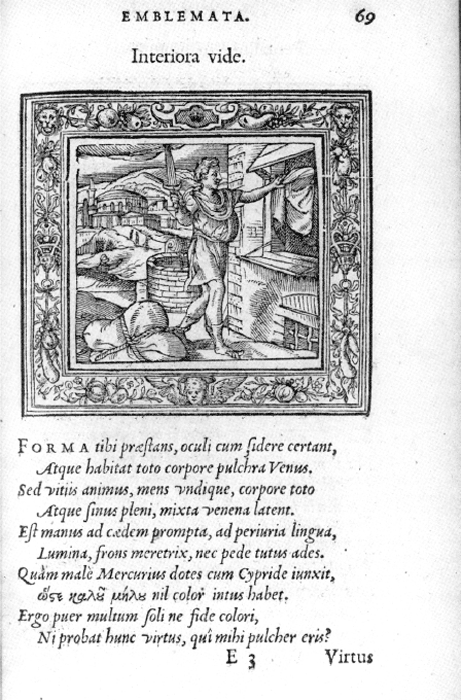
Fig. 1: Emblem 50: ‘Interiora vide’: Sambucus, Emblemata, Antwerp: Plantin, 1564; Les Emblesmes, Antwerp: Plantin, 1567.
| |
[pagina 143]
| |
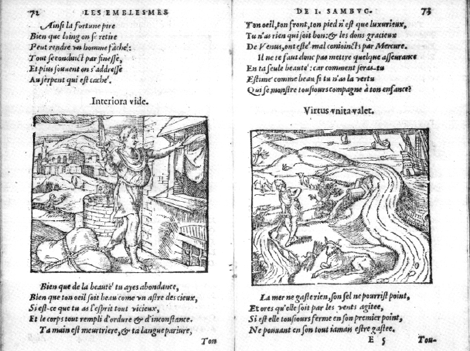 | |
[pagina 144]
| |
to be aiming for simplicity and unity, and merely repeats the term ‘beauté’ from line 1. Sambucus too used ‘pulcher’ at both the beginning and the end, in a way which serves to foster a sense of conclusion. But in the French, Grévin lays more stress on emphasising the movement from the beginning to the end of the poem: he uses ‘beauté’ (for ‘color’) as well as ‘beau’, and also contrives to end the poem with the same rhyme (in -ance) as in the first stanza. This concern with unifying the poem seems to be another underlying priority of Grévin's.
Even if these main tendencies, a preoccupation with simplifying and unifying, often related to the development of a strong onward movement, and the explanation of Classical references seem to recur throughout the collection, Grévin is not always equally successful. Indeed at times Grévin gives the impression that he was virtually writing down the first thing that came into his head: some translations are banal and summary in the extreme, and one cannot help wondering whether he was working against the clock or had really lost all patience with the project. This can be sensed for instance in the 70s, 80s and 90s: maybe it is significant that this series of, in the main, weak translations is about halfway through the volume, as if Grévin were despairing of ever completing the work for which, after all, he was not being conspicuously well paid.Ga naar voetnoot4
Emblem 77, ‘Non dolo sed virtute’, is characteristic of these less successful translations (see figure 2). The Latin subscriptio consists of sixteen hendecasyllabic lines, which Grévin converts into | |
[pagina 145]
| |
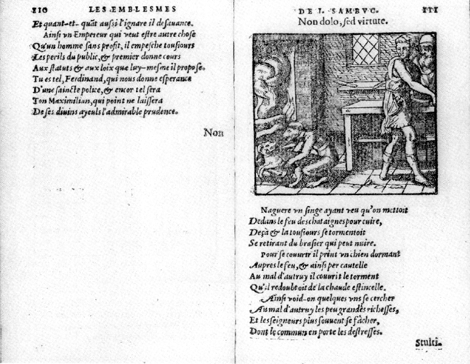
Fig. 2: Emblem 77: ‘Non dolo, sed virtute’: Sambucus, Emblemata, Antwerp: Plantin, 1564; Les Emblesmes, Antwerp: Plantin, 1567.
| |
[pagina 146]
| |
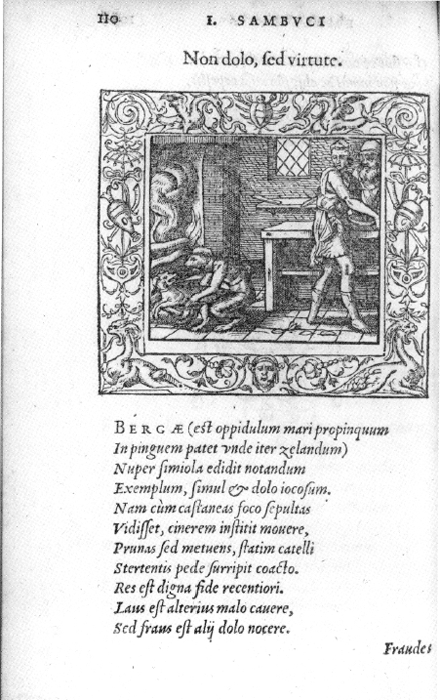 | |
[pagina 147]
| |
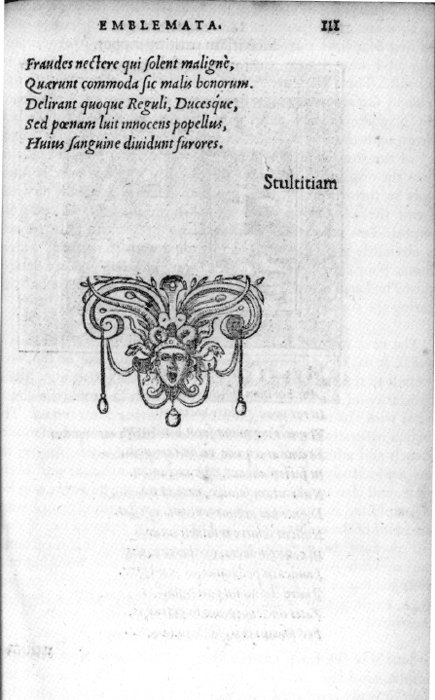 | |
[pagina 148]
| |
twelve decasyllables, arranged in three four-line strophes, rhyming abba etc... The Latin has a fable-like quality at the outset with the first four lines introducing the story by setting it geographically and underlining the mood of the tale, an ‘exemplum jocosum’. These lines are not translated at all: the only attempt made by Grévin to recreate the mood of a ‘good story’ is the opening ‘Naguère’ (a short time ago). The first strophe of the French corresponds roughly to lines 5, 6, and 1/2 of 7. The Latin recounting of the story is brief and factual, whereas the French tends to gloss the original: thus we see the monkey who ‘De ça et la tousjours se tormentoit’ (a nice touch in what is generally a weak poem: the alliteration tou is probably deliberate and certainly helpful). Less successful, however, is the ‘brasier qui peut nuire’, so obviously a filler contrived to rhyme with the already superfluous ‘pour cuire’. Nobody needs to be told that fires are dangerous! The Latin is more straightforward ‘Prunas sed metuens’ (but fearing the coals).
The next strophe of the French renders the rest of line 7 and line 8. It has to be admitted that the Latin could not be rendered literally and a certain amount of expansion was essential: a literal translation of the Latin would be: ‘forthwith he stole [the chestnuts] with the foot of the sleeping dog having been forced’. The French naturally sorts out the syntax according to the demands of French and adds extra material to fill out the lines: ‘Aupres du feu’ is pleasantly atmospheric, and fits the woodcut, as well as the sense, and also contributes to the idea of a poor innocent dog being exploited in this way! ‘Per cautelle’ (by cunning) emphasises the point of the emblem recalling ‘dolo’. The repeated use of ‘couvrir’ perhaps also suggests this idea of deceit, and this is certainly the case with ‘Au mal d'autruy’. But the fourth line, restating once more his fear of fire seems excessive, especially since it is not even made explicit that what the monkey actually does is steal the chestnuts!
Line 9 of the Latin returns to the technique of storytelling by emphasising that what we hear is true - and, like the first four lines, it is not translated. Nor are lines 10 and 11 which, with their | |
[pagina 149]
| |
parallel structures and the happy rhyming of laus and fraus, are clearly striking and memorable in the original. Maybe a translation would inevitably have lost too much and so was deemed better not attempted. And in a sense the additions in the previous strophe have already made the point, though not nearly so memorably. Some compensation is found though in the repeated ‘Au mal d'autruy’ which emphasises the link between the moral and the exemplum. The closing lines in both Latin and French narrow the application of the emblem to rulers,Ga naar voetnoot5 but the French is a pale echo of Sambucus: the Latin is powerful: ‘Sed poenam luit innocens popellus, Huius sanguine dividunt furores’ with the emphasis on the spilling of innocent blood and the alliteration of p; in comparison the French ‘Dont le commun en porte les destresses’ is banal in the extreme.
A similar tendency towards banality can be seen in Grévin's translation of emblem 60, ‘Iniuria gravis est omnibus’ (see figure 3). The fourteen lines, again elegiacs, of the Latin are rendered by four stanzas of six seven-syllable lines. The theme is the desire for vengeance, and the motif is the sponge unfairly ripped from the rock. The Latin introduces the motif and the theme in the first four lines which provide the material for the first stanza in French. Liquid ‘l’ and soft ‘v’ sounds are delightfully suggestive of the soft damp sponges (‘mollis, bibula & scopulis avelliture udis/Spongia...’ etc.), and contrast with the harsh plosives of the reactions when similar ill is done to living humans: ‘Hinc odium, caedes, ultio moesta, furor’. The French too starts with a succession of soft sounds (‘l’, ‘ch’, soft ‘g’), but cannot reproduce the harshness of line 4 of the Latin. Moreover the accumulation of four ills which result from unjust treatment is reduced to two (‘...autant de mort/Et de haine l'on assemble’), with the rhyming of ‘mort’ with ‘tort’ in the previous line the only attempt tot recreate the dramatic sense of the original. | |
[pagina 150]
| |
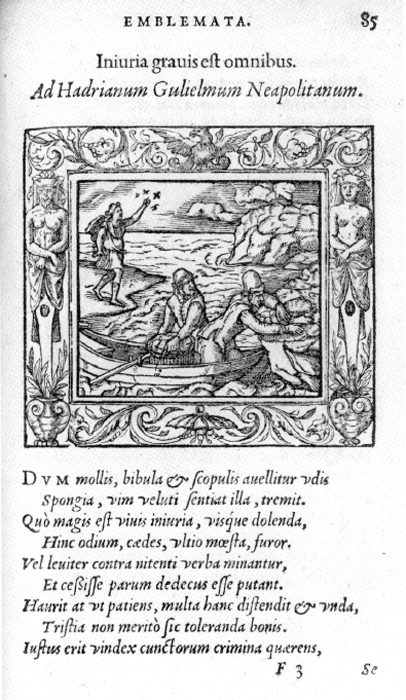
Fig. 3: Emblem 60: ‘Iniuria gravis est omnibus’: Sambucus, Emblemata, Antwerp: Plantin, 1564; Les Emblesmes, Antwerp: Plantin, 1567.
| |
[pagina 151]
| |
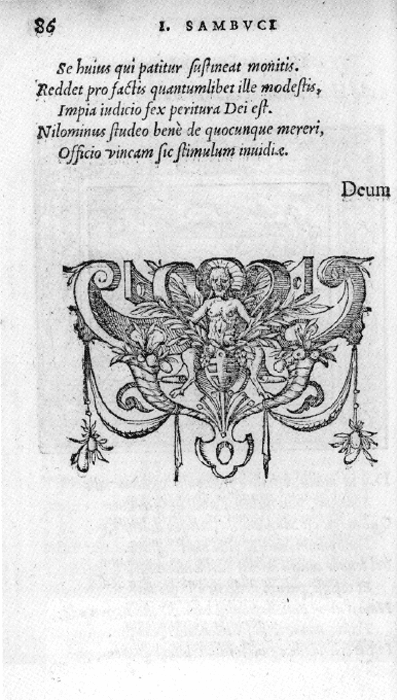 | |
[pagina 152]
| |
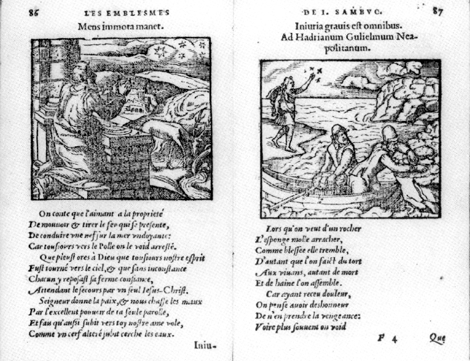 | |
[pagina 153]
| |
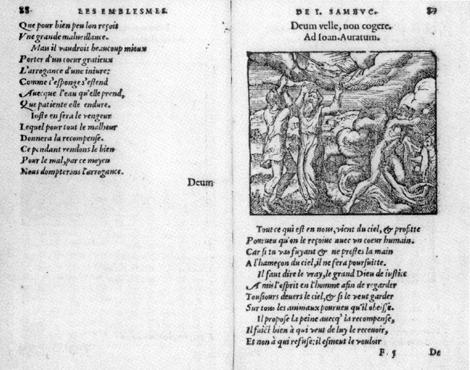 | |
[pagina 154]
| |
The expansion involved in the next stanza of the French, corresponding to only two lines of Latin (lines 5-6) similarly weakens the impact. When Sambucus returns to the image of the sponge to express how patient absorption of wrong is preferable to exacting vengeance, sound again has an important role to play, with a pattern of long, especially nasal vowels in lines 7-8. Once more the French expands on the original: while the nasal vowels recur in the French, the greater length allows Grévin to spell out the the moral implications (‘il vaudroit beaucoup mieux’) in more heavy-handed fashion. Surprisingly then, the final moral stance is in fact less elaborated on in the French: Sambucus underlines the contrast with the final judgment of God, and concludes, in the first person singular, with determination to do his duty to be fair to everyone. It is, I think, the use of the first person plural, coupled with the introduction of the rhyme ‘recompense’: ‘arrogance’ (for Latin ‘invidiae’) which makes the moral conclusion here, despite the omission of any reference to God, unpleasantly self-satisfied (lines 19-24): Juste en sera le vengeur
Lequel pour tout le malheur
Donnera la recompense.
Ce pendant rendons le bien
Pour le mal, par ce moyen
Nous dompterons l'arrogance.
One further example of Grévin's weaker translations will suffice: emblem 133, ‘Expediens impedior Bombyx’, in which the hapless silkworm is used as a metaphor to express the fate of one who serves, suffers and ultimately dies for someone else's gain (see figure 4). Once more the Latin (ten lines, elegiacs) is translated into a strophic form, four four-line stanzas made up of alexandrines. The first 2 1/2 lines of the Latin give us the first stanza; the striking features of the Latin are on the one hand the adjective ‘pendulus’ which graphically conveys the silkworm's literal position and the degree to which it is bound by its task, and on the other by the repeated ‘opus’/‘opere’ (supported by a pattern of ‘o’ sounds), reflecting its entanglement. Both of these are lost in the French, whereas the French resorts to a banal expression of quantity, | |
[pagina 155]
| |
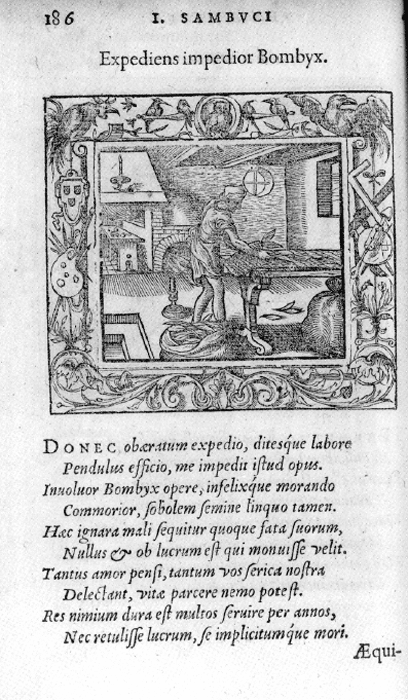
Fig. 4: Emblem 133: ‘Expediens impedior Bombyx’: Sambucus, Emblemata, Antwerp: Plantin, 1564; Les Emblesmes, Antwerp: Plantin, 1567.
| |
[pagina 156]
| |
 | |
[pagina 157]
| |
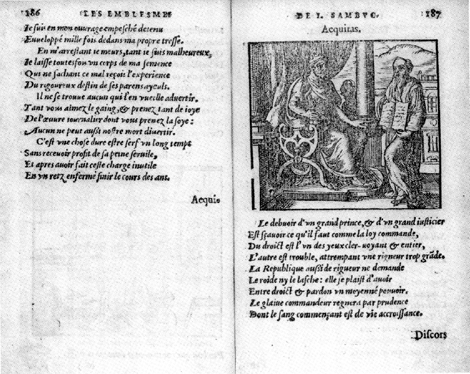 | |
[pagina 158]
| |
‘mille fois’ to emphasise the creature's predicament: Je suis en mon ouvrage empesché detenu
Enveloppé mille fois dedans ma propre tresse.
The ‘o’ sound is continued in the Latin, and a further sound patterning is introduced with the punning of ‘infelixque morando/Commorior’ (lines 3-4) which cannot be replicated in French, though Grévin makes an interesting attempt at an equivalent with the alliterative ‘En m'arrestant je meurs, tant je suis malheureux’. Overall however, the next stanza is more wordy and discursive than the original (Latin 2 1/2 lines to line 5, French lines 5-8), with the introduction of ‘tant’ and ‘qui’ to express the relationships between clauses, and the emotive but conventional adjective ‘rigoureux’ to qualify the destiny which awaits the worm.
The third stanza is drawn from lines 6-8 of the Latin. Here, the gains which mankind extract from the silkworm are emphasised through three separate expressions: Nullus & ob lucrum est qui monuisse velit
Tantus est amor pensi, tantum vos serica nostra
Delectant... (6-8)
with the two latter further stressed by the use of ‘tantus/tantum’ in key positions in the line. In the French, there is only one expression used for financial profit, ‘gaing’ instead of both ‘lucrum’ and ‘pensi’. Perhaps the longwinded ‘oeuvre journalier’ presents some compensation: Tant vous aimez le gaing, & prenez tant de joye
De l'oeuvre journalier dont vous prenez la soye...
The last stanza in Latin not only returns to the paradox of human gain, ‘lucrum’ again, set against the silkworm's death, but also to the key word ‘mori’ (cf. line 4) which is actually the last word of the poem. While the French use of the noun ‘serf’ instead of the verb (‘servire’ in Latin) could be said to aid the emphasis on the application of the moral to the human condition of slaves/servants, the concluding euphemistic expression ‘...finir le cours des ans’ rather than a reference to death greatly lessens the final harsh impact which Sambucus had produced. Altogether, the French version strikes me as rather watered-down in comparison with | |
[pagina 159]
| |
Sambucus' original, with longer discursive expressions often substituted for clever and memorable juxtaposition and sound patterning.
There are a few instances where Grévin appears to misunderstand the Latin, or, if not misunderstand, deliberately opt for a contradictory sense. This would appear to be the case in emblem 30, ‘Laus in fine’: the theme is the value of a peaceful resolution to a conflict which only God can bring, and this general idea is equally clear in both Latin and French. However Sambucus comments in the second stanza of his text (lines 7-8): Homerus Ulyssem πτολιπορθον, &
Victorem, Achillem nec vocat gravem.
The point is that Homer himself was critical of these heroes despite their obvious valour (‘nec vocat gravem’), whereas Grévin translates in a way which does not imply any criticism (lines 5-6).Ga naar voetnoot6 Ulysse est appellé par Homere, homme acort,
Achille est estimé victorieux & fort...
Grévin's version of emblem 147, ‘Simile à simili non laeditur’, though, gives a completely different sense to Sambucus' original. The eight-line Latin poem contrasts the behaviour of dogs and robbers, which only attack those weaker than themselves, with that of virtuous men who will not fight someone who is already down but instead increase their valour by attacking the arrogant (lines 7-8): Crescit at in duris virtus, maiora meretur,
Abstinet à victis, inque suberba ruit.
The allusions to dogs and robbers are comparably rendered by Grévin, in the first two of his three four-octosyllable strophes, though more emphasis is given to the suffering of the weak dog than the underlying agression which is really the point. But in the final strophe the sense is completely changed: Mais la vertu tout au contraire
Veut aux plus infirmes complaire.
L'homme vaincu & abbattu
Est soulagé par la vertu.
| |
[pagina 160]
| |
Grévin has given to ‘vertu’ a sense quite different from that of the Latin ‘virtus’ as it occurs in this context (though both terms, of course, can cover a wide range of meaning). ‘Virtus’ is not military valour or bravery, and no reference at all is made to defeating the arrogant.Ga naar voetnoot7 Instead, ‘vertu’ has acquired the idea of concern for others, and the whole military ethos and set of values has disappeared. This is consistent with the change of emphasis Grévin gives to his version of emblem 19, ‘Consilium’ (see p. 177).
Sambucus is likely to have been particularly annoyed at Grévin's treatment of emblem 137, ‘Antiquitatis studium’, since it is concerned with a subject so dear to his own preoccupations: his emblems are followed by a display of Roman medals which he himself had collected. The Latin text stresses two elements, firstly the way in which all things, even symbols of imperial power, are destroyed, and secondly how God has brought about the remarkable discovery of ancient marbles and medals as an incentive to good (lines 5-7): Hinc Deus in frugem veterum virtute probatam
Ut vocet en monstrat marmora, Roma, tibi.
Effodiuntur opes irritamenta bonorum...
Grévin plays down the transience of all things, seeming to suggest that Ancient things are exempt: ‘l'antiquité.../Demeure avec le temps à jamais perdurable’ (lines 3-4); hence there need be no reference to God's intervention to bring relics to light. More importantly the idea that these relics can be an inspiration to virtue is excluded. The only mention of virtue is that the marbles ‘Monstrent la grand’ vertu des hommes esprouvez’ (line 6), but the emphasis is on past virtue rather than present. | |
Signs of Grévin's personal spheres of interestThe differences between the Latin and the French are of course in part due to the differences between the two languages; never- | |
[pagina 161]
| |
theless, there is no doubt in my mind that Grévin's versions are extremely variable in standard, and some attempt must be made to elucidate the factors concerned. While I am tempted to lay the responsibility for the generally weak group of emblems in the middle of the book on the psychological factor of the middle point in a long work, when it comes to evaluating the French versions which strike the reader as exceptionally successful, clearly a more positive reason must be sought. It seems that certain topics particularly engaged Grévin's attention and enthusiasm.
Emblems 142 and 153, for instance both touch on the problem of drunkenness and they seem to have aroused a personal interest in Grévin. ‘Avaritia huius saeculi’ (142) was bound to interest Grévin since it is concerned with the question of artistic patronage. The first eight elegiac lines of the Latin (giving the first 12 decasyllabic lines of French) describe the two different doors (for rich and poor) which give access to the rich man's house, and bewail the lack of welcome extended to those following the Muses. Grévin unusually develops the references to the Classical Muses who, because of the meanness of the age, get no chance to be awakened. More interesting for our purposes though is the latter part of the poem (lines 9-14 in Latin; 13-22 in French) although Grévin does not mention the specific Latin poets (Horace and Vergil) that Sambucus says would not have a chance to flourish in his day, he greatly strengthens the impact at this stage; Sambucus expresses the lack of respect shown to poets in abstract fashion: Exulat ingratum carmen, facundia passim
Temnitur, & cultis artibus aula caret. (11-12)
whereas one senses the bitterness of personal experience in Grévin's emotive lines: Les vers sont morts, on ne sait que rire
De celluy-la qui s'apprend à bien dire. (17-18)
Sambucus finishes his poem with a comment on the welcome given to ‘bibuli’, but this is emphasised in the French by setting up a contrast between them and the ‘doctes’ who obviously include himself: Parmy les cours les doctes sont les derniers,
Et les beuveurs sont receus les premiers.
| |
[pagina 162]
| |
Ils font vertu d'estre riches en terre,
Ou d'esgoutter à qui mieux-mieux un verre. (19-22)
The final couplet gives an impression of the scorn in which he holds the drinkers, much stronger than anything in Sambucus: the riches are purely ‘en terre’, a clear allusion to the contrast with treasures in Heaven (Sermon on the Mount, Matthew 6, 20-21) and the valuelessness of the drinking is conveyed through the colloquial ‘esgoutter à qui mieux-mieux un verre’.
In 153 too, ‘Poena sequens’, Grévin gives more emphasis to drunkenness than Sambucus does.Ga naar voetnoot8 In this story, a thief, having enjoyed a welcome drink, falls asleep such that the weight of his bag of booty strangles him. Sambucus does not explicitly speak of inebriation, or indeed identify the drink: the thief is merely ‘defessus’ (line 5). But Grévin elaborates: ‘S'estant enivré largement...’. Another interesting feature of this emblem is the fact that Grévin clearly has the woodcut in mind when he composes his version (see figure 5): Il s'endort reposant sa charge
Dessus une grande table large,
D'ont le sac grillant vistement
Le renversa... (lines 6-9)
The situation is perhaps difficult to envisage, but the artist has produced a relatively plausible scenario, with the thief reclining, his head, and thus his load, on the table. Sambucus, doubtless writing before the woodcut was produced is much vaguer, leaving the emphasis on the just deserts rather than the physical details (‘...sponteque punit onus’).Ga naar voetnoot9 | |
[pagina 163]
| |
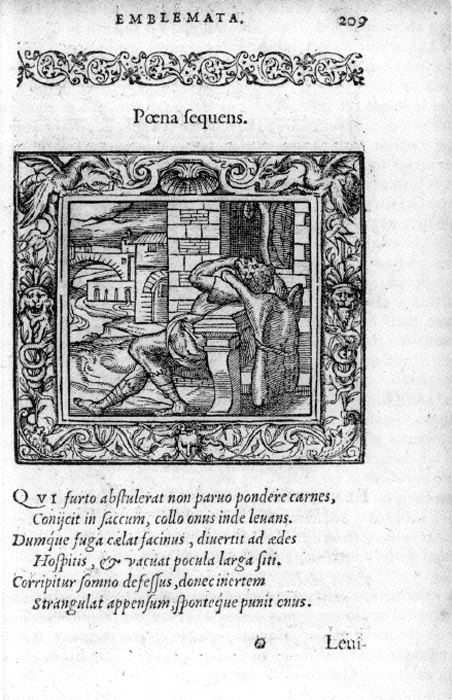
Fig. 5: Emblem 153: ‘Poena sequens’: Sambucus, Emblemata, Antwerp: Plantin, 1564.
| |
[pagina 164]
| |
Another emblem which in Grévin's version has a very personal ring about it is 111, ‘Felicitas indigna, vel superflua’. This, like 142, bemoans his lack of financial resources, exploiting as in 133, the image of the silkworm that labours for the gain of others. Both the Latin and the French are personally expressed in the sense that both use the first person singular. Sambucus places emphasis on the lack of effort required to produce the silk, but in the French the contrast with the poet's own position is stressed with ‘riche (richesse)’ repeated three times, and ‘sans’ twice (‘sans soucy’; ‘sans main’) to express the unjust lack of participation by the exploiters. Grévin's envy takes on an almost petulant tone at the end of the first stanza (French lines 1-6, based on Latin 1-6): Je voudrois bien que d'un tel revenu,
A tout jamais fust mon bien maintenu. (5-6)
Sambucus, echoed by Grévin carries on the argument that these fortunate circumstances only arise for those who inherit wealth from their fathers (Latin lines 7-10; French 7-12); but Grévin maintains the rather petulant tone with the word ‘richesse’ repeated yet again, and distancing himself from this situation with the phrase ‘...à ceux la qui ont les heritages’. The final couplet of the Latin (lines 11-12) is expanded into a full 6-line stanza which allows Grévin time to give an original twist to the conclusion: Sambucus' sentiment was that gains for which we have not laboured are dangerous, so he will be satisfied with what he has worked for; but Grévin expresses this more emotively and with greater emphasis on his own position: ‘Quant est de moy...’, and ‘ce seul bien seul me contentera’. The repeated ‘seul’ may be a little heavy, but it conveys his own sense of superiority (or sour grapes?!) compared with those lucky rich who do not have to work.
Another emblem on the theme of riches receives particularly successful treatment from Grévin, ‘Divitiae inutiles’ (37, see figure 6): the Latin consists of twelve lines in elegiac couplets, and the French sixteen lines (four four-line strophes of alexandrines, rhyming aabb etc.) Grévin evidently thought that the allusion at the beginning of the emblem which provides the motif for the woodcut required elucidation for a vernacular reader (as it might well for a modern reader): thus where Sambucus glosses the fame of | |
[pagina 165]
| |
Xerxes' plane treeGa naar voetnoot10 by saying that every cicada was known, Grévin explains instead its relevance for the understanding of the emblem, that it was enclosed. Alongside the omission of the cicada, the familiar (in Classical terms) image of Fama is also omitted from the French. Moral implications are immediately clearly articulated with the insertion of ‘pourtant’ and ‘Mais’. I think that the stress provided in Latin by the alliteration in ‘m’ of ‘miseris... malis’ is given in the French by the positioning of ‘Aux pauvres souffreteux’ and its expansion ‘que l'on void quaimander’ (= beg): La plane de Xerxes fut beaucoup renommee,
Et pourtant elle fut tout autour enfermee:
Mais que servent les biens, si non pour en aider
Aux pauvres souffreteux que l'on void quaimander?
The next four lines of the Latin correspond to the second stanza of the French and the French can again be said to be simplified. Most noticeable is the reduction in the number of terms used for wealth (‘munera’, ‘opibus’, and ‘aurea’ back in line 3), in favour of ‘bien’, and the use of ‘bon’, qualifying the friends he could help, to render the whole idea ‘notum cana fide’, that is ‘known for old loyalty’. At first sight ‘bon’ is a distinct weakening, but on the other hand it makes a link with ‘bien’ which seems positive overall. The visual idea of hiding wealth (‘imis si lateantque locis’) gives way to the sense it infers, that is being of no use, ‘...dont on ne peut retirer le service’.
The last part of the Latin on the other hand is expanded, with 9-10 providing the material for the third strophe, and 11-12 for the fourth. The exclamatory tone of ‘Heu stultos’ (lines 9) is quite faithfully reproduced, but the following relative is wordier in French. Latin line 10 was eminently quotable ‘Magnus enim qui dat, si capit inde nihil’ and the chiasmus stresses the contrasting attitudes. This would be difficult to reproduce in French, and instead Grévin opts for a system of sound patterning with the ‘donne’ repeated three times (lines 11-12): | |
[pagina 166]
| |
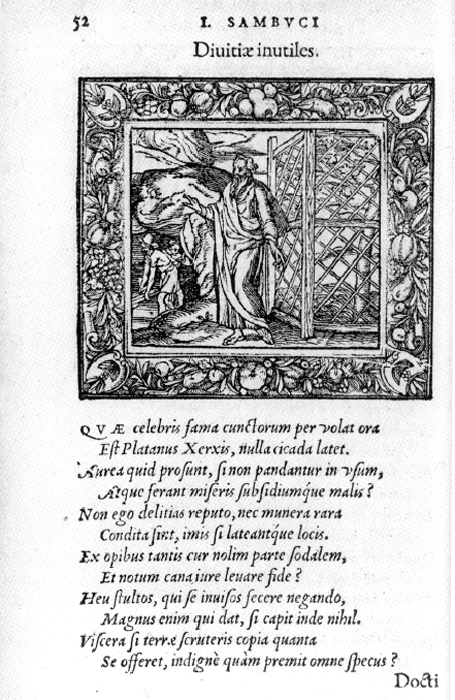
Fig. 6: Emblem 37: ‘Divitiae inutiles’: Sambucus, Emblemata, Antwerp: Plantin, 1564; Les Emblesmes, Antwerp: Plantin, 1567.
| |
[pagina 167]
| |
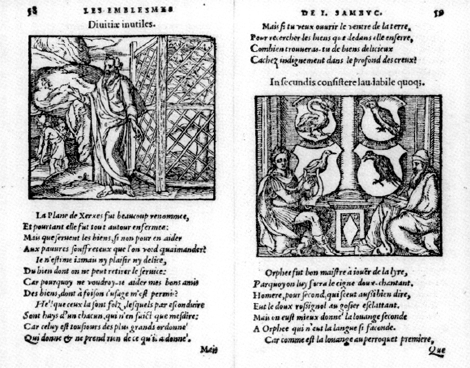 | |
[pagina 168]
| |
Car celuy est tousjours des plus grans ordonné
Qui donne & ne prend rien de ce qu'il a donné.
The last two lines of the Latin introduce another word for wealth (‘copia’) which again is translated by ‘bien’; indeed the expansion in the French means that ‘bien’ is used twice in this strophe, once qualified by the adjective ‘delicieux’. This contrasts effectively with the ominous ‘ventre’, a literal translation of ‘viscera’, and the expanded ‘profond des creux’ for ‘omne specus’, both terms for the hiding places of treasures. The contrasting relationship of the stanza to the rest of the poem is made clear in the introductory ‘Mais’ of line 13.
This characteristic of spelling out logical relationships, rather than relying on juxtaposition, seems to be part of Grévin's normal working practice and perhaps almost a function of French as opposed to Latin. More noteable are the completely different ways in which Sambucus and Grévin express the idea of wealth here: Sambucus goes for variety, one might almost think deliberately using as many different words as possible, though none of them at all unusual, whereas Grévin opts for simplicity and unity, with considerable repetition, and produces, if not exactly a powerful poem, one which will impress its readers and so must be regarded as successful.
Given Grévin's evident interest in the subject of wealth, his version of Sambucus' emblem 97, ‘Interdum requiescendum’ takes on a special poignancy. The proportions of the two poems on this occasion remain very similar, with ten lines of Latin dividing equally to give two stanzas of six alexandrines. But nevertheless, the overall impression is very different. Where the Latin starts with a calmly expressed, generalized statement ‘Est cunctis requies tribuenda...’, the French begins strikingly: ‘Non, il n'est pas besoing de tousjours travailler’, followed up by the importance this has for both mind and body; this is likened to the need to leave land fallow, and the whole is explained because ‘les astres’ designed things that way, a justification lacking in the Latin. The conclusion in both versions is the same, the need for moderation, | |
[pagina 169]
| |
but in the French the ground for this is better prepared in the handling of the next image, the bow which must not be treated in too extreme a fashion. In the French the different treatments are presented as alternatives, linked by ‘ou’ instead of Latin ‘...que’ (=and), and thus the need for a middle path between the two extremes is better prepared for.
Emblem 31, ‘Res humanae in summo declinant’, represents another response to the unequal distribution of wealth: that all of us are nevertheless equal in death. Sambucus' ten lines in elegiacs gives sixteen decasyllables in French. The Latin is to my mind one of Sambucus' most successful, with its stark opposition of light and dark, careful word order (for instance the emphatic ‘Nil’ and ‘Mors’ at the beginning of lines), his usual propensity for alliteration and sound patterning more generally, and a mood of pathos. Grévin eliminates the light/dark antithesis at the beginning of the poem, instead making explicit the role of fortune which was doubtless implicit in the motto. This makes the sense clearer but is less emotive than the Latin: ‘Et nihil aeternum, quod rapit atra dies’. Sambucus follows this immediately by the well positioned ‘Nil iuvat...’, whereas the French, characteristically is more discursive: Bien que les Rois aux grand palais demeurent,
Si faut-il bien qu'en la parfin ils meurent.
The rhyme ‘demeurent/meurent’, precisely because it is traditional, underlines the inevitability of death for us all and thus creates an emotive effect. Grévin appears to have been particularly concerned to enhance the unity of this poem. Thus, as elsewhere, he tends more to repetition than Sambucus. Earlier on we had seen how fortune was always ‘renversee’ (line 4), and he uses the same word again in expressing the speed with which death can strike us down: Et plus subit nous nous sentons renversez
Qu'à la chaleur d'une grande lumiere
Ne se fletrist la rose journaliere.
The image of the rose withering as a symbol of the passage of time is of course a commonplace, derived from Ausonius and the Greek Anthology, and already implied in the Latin: | |
[pagina 170]
| |
Heu, leviter ventus pellit nos omnis inermes,
Concidimus citius quam levat aura rosas.
Grévin does not replicate the exclamation (‘Heu’), and the contrast between the soft ‘v’ and ‘l’ sounds and the harsh ‘k’ repeated three times (and ‘d’) at the beginning of the last line is lost. Nevertheless, Grévin maintains his own priority of fostering unity, by adding the motif of light/heat to that of the wind, thus recalling the initial image of Phoebus melting the snows from the beginning of the poem.
The theme which most often seems to inspire Grévin to give of his best, however, is undoubtedly religious faith. Emblem 25, ‘Subitae divitiae obliviosae’, combines this with that of riches which we have already seen to be of abiding interest to him (see figure 7). The theme of the emblem is how to react to sudden gifts of Fortune: we are warned not to take them for granted since Fortune's wheel may turn on; as in emblem 31, this constitutes an attempt to come to terms with an insoluble problem. The Latin consists of thirteen hendecasyllabic lines, whereas Grévin's vernacular is strophic, comprising four stanzas of eight six-syllable verses. The exigences of the short lines, that is the need to create frequent rhymes, are the weakest point of the poem, much more difficult to handle than the sound patterning/alliteration of the Latin, but thematically the French constitutes a unified verson with a marked Christianisation. The first four lines of the Latin provide the material for the first stanza: the role of Fortune in providing riches is stressed, with the virtual synonym ‘sors’ in line 4, whereas at this point Grévin gives no emphasis to the source of wealth; more importantly, Sambucus expresses the newly rich men's neglect of their obligations in Classical terms: ‘Obliviscimur impii Deorum’, whereas in the French it is a single (so Christian) God:Ga naar voetnoot11 Lors nous n'avons la cure
De la grandeur de Dieu...
| |
[pagina 171]
| |
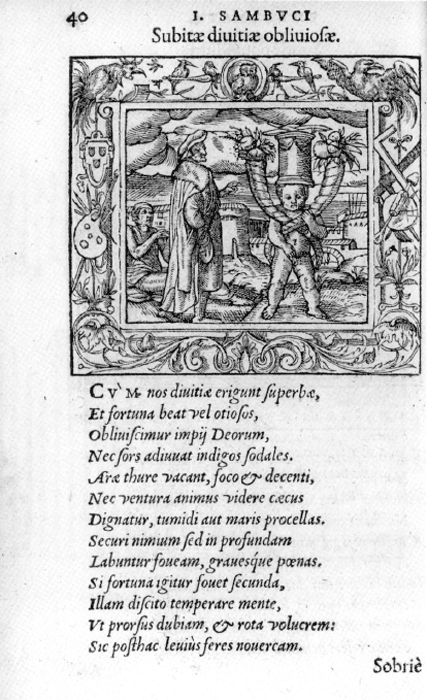
Fig. 7: Emblem 25: ‘Subitae divitae obliviosae’: Sambucus, Emblemata, Antwerp: Plantin, 1564; Les Emblesmes, Antwerp: Plantin, 1567.
| |
[pagina 172]
| |
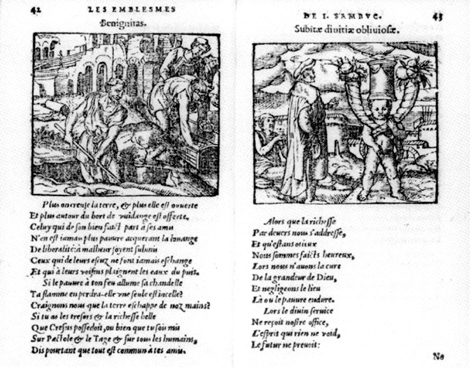 | |
[pagina 173]
| |
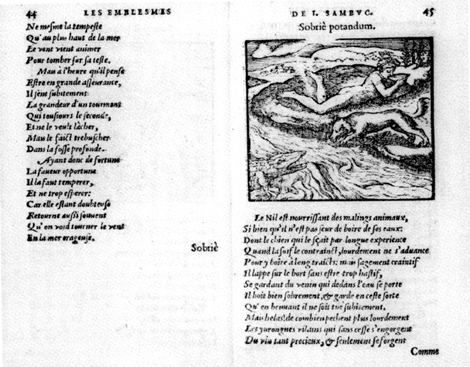 | |
[pagina 174]
| |
Similarly, in the second stanza (corresponding to lines 5-7), references to altars, insense and fire (clearly sacrificial altars), again neglected in favour of enjoying wealth, are replaced by ‘le divin service’. Of course this does not provide the visual element present in the original, but Grévin makes up for this later in the stanza where he greatly expands on the original allusion to a storm at sea, which is likewise overlooked. Storms and wind (as in 31 above) are of course a common metaphor for unpredictability, in emblems and elsewhere, and a brief allusion, not even a full line, is enough for the sense to be clear, but Grévin devotes a full four lines to the storm whipped up by the wind, and the suffering it can cause someone who does not foresee it: ‘Pour tomber sur sa teste’. The harsh repeated ‘t’ here (and earlier) is probably an attempt to reproduce the kind of sound patterning more generally characteristic of the Latin.
The next two lines (lines 8-9) of the Latin are even more dramatically expanded, to form the whole of the third strophe. The Latin is striking in its simplicity perhaps: Securi nimium sed in profundam
Labuntur foveam, gravesque poenas.
but the French has its own power despite a certain wordiness: Mais à l'heure qu'il pense
Estre en grande asseurance,
Il sent subitement
La grandeur d'un tourment
Qui tousjours le seconde,
Et ne le veult lâcher,
Mais le faict trebuscher
Dans la fosse profonde.
The metaphor of the storm is extended through the use of the word ‘tourment’, meaning both storm and pain, and the impression of threat is increased by its personification (‘seconde’, ‘lâcher’. Moreover the word ‘grandeur’ recalls the first stanza (‘grandeur de Dieu’) and thus suggests that the suffering is no more than a just punishment for neglecting one's duties. The verb ‘trebuscher’ of course leads us back to Fortune, since it is so commonly used for being cast down by Fortune, and that is indeed the topic of the | |
[pagina 175]
| |
last stanza, corresponding to lines 10-13 of the Latin. The Latin is characterized by two main devices, near punning (line 9 ‘foveam’ = pit; line 10 ‘fovet’ = favours) and the image of Fortune as a stepmother (‘noverca’). Neither of these is reproduced in the French, though there is a noticeable alliteration of ‘f’. Instead, Grévin returns again to the sea and the storm to provide his final image and indeed impression. The idea of the moral is that we must not be too carried away when things go well, so that we will manage better when they go badly: ‘Illam [=fortunam] discite temperare mente’. Grévin strengthens this injunction by advising us not to ‘trop esperer’. Sambucus refers to Fortune's wheel as well as comparing her to a stepmother. Even the wheel is explicitly excluded in French, though suggested by ‘trebuscher’ earlier and also ‘Retourne’ and ‘tourner’: Car elle [=fortune] estant doubteuse
Retourne aussi souvent
Qu'on void tourner le vent
En la mer orageuse.
In effect, Fortune has been stripped of the attributes which made her an active allegorical figure. Instead now it is possible to integrate all elements of the poem into a satisfactory Christian context, with fortune (not Fortune) being used in a weak sense, merely what happens by chance. The traditional associations of Fortune are maintained only at the most elusive level, and the image of the stormy sea is exploited to the full to give a powerful and unifying ending to the text.
Emblem 95, ‘Simul & semel’, is one of Grévin's more successful vernacular versions. The emblem takes the motifs of the hammer and the anvil to illustrate how impossible it is to separate different elements in God's creation, that is specifically in Man. The Latin consists of fourteen lines in alternate hexameters and iambic dimeters, and the French is rendered by three four-line alexandrine strophes. The first six lines of the Latin are devoted to the images and the ridiculousness of the question: compressing this into a four-line strophe involves a degree of reduction, with the relative functions of hammer and anvil no longer mentioned. Mo- | |
[pagina 176]
| |
re interesting is the adaptation of lines 7-11 into the second strophe.Ga naar voetnoot12 Both versions stress God's omipotence, allowing Him to create all things as he wishes them, but Grévin glosses this with an original emotive comment: ‘d'autant/Qu'ayant pouvoir sur tout, il est tout bon & sage’. This implies a desire not only to convince but to move the reader, and the lines form the crux of the French version. They are in keeping with the tone at the end of Sambucus' text where he urges us, personally, not to worry about such problems, but Grévin gives new emphasis to the positive aspect of God's goodness.
Grévin indeed habitually changes the emphasis of Sambucus' original in quite a major way to bring out the Christian element. Emblem 99, ‘Neglecta virescunt’ (the poem, not truly an emblem, dedicated to the other emblematist who was to occupy Grévin, Hadrianus Junius), is a case in point. In the Latin, Sambucus starts in general terms, stating that the virtuous, though despised, will find fame and reward, just as ivy on a wall and the snake (symbol of prudentia) hidden within it cannot help but flourish. Grévin takes this a little further. ‘D'un chacun ils sont aimez’ (line 12) which is almost contradictory. However, his true priorities emerge later: he has shifted the attention from Junius (who, Sambucus argued, even when in hiding in Harlem, would deservedly, on account of his mind (ingenium), enjoy respect) on to the city of Harlem itself: Harleme, pour tes vertus,
Tu en auras recompense,
Et verray par ta puissance
Tes envieux combatus.
While Sambucus had railed, in a series of rhetorical questions, against the suffering caused by envy, this is developed by Grévin | |
[pagina 177]
| |
into the desire to see the envious defeated, and in the closing line into the confidence that the envious will be punished ‘Par une divine loy’. This is in marked contrast to the end of Sambucus' poem where he comments on the deserved punishment of Momus and Zoilus, classical allusions which would of course have been lost on a vernacular reader. Thus ultimately, Grévin generalises his poem to have greater significance than merely an encomium of Junius, and so in a sense makes it more emblematic because less individual and hence limited. Moreover, importantly, he introduces the idea that the punishment of envy is part of a divine plan.
The importance of ‘loy divine’ comes to the fore again in emblem 19, ‘Consilium’, where the general sense is the value of rational thought. Here, however, the phrase is used slightly differently, and in quite a different way from Sambucus' original argument. The Latin consists of fourteen lines, elegiacs, whereas the French is transformed into ten strophes of four seven-syllable lines, with a remarkably lyrical tone at times. The most important differences occur in Grévin's translation of lines 5-6: Militiae doctrina valet, sanctusque Senatus,
Atque domum tuta conditione tenet.
Both ‘militiae doctrina’ and ‘Senatus’ here convey the idea of proper order, and ‘sanctus’, I think, merely implies the respect due to government rather than a specifically religious, let alone Christian sense. We have to interpret line 6 as signifying that both elements keep us/the home safe. In French the whole sense is changed (lines 9-16): Par luy [=conseil] la vray doctrine
De la saincte loy divine,
Et l'art que la guerre suit
Plus sagement se conduit.
Le maison bien ordonnee
Par conseil est gouvernee:
Par le conseil seulement
L'on y vit plus seurement.
Grévin transposes the two elements, and ‘la vray doctrine/De la saincte loy divine’ must be taken as a translation of ‘sanctus Sena- | |
[pagina 178]
| |
tus’. He gives its modern sense to ‘doctrine’, rather than the wider one simply of ‘learning’. Moreover, whereas, in the Latin, ‘militiae doctrina’ and ‘Senatus’ were examples of ‘consilium’ at work, now they are made to be subject to ‘conseil’; I am tempted to think that Grévin is expressing his views on the horrors of the religious conflict of his time. This is consistent with his emotional tone (for instance here in the repetition of ‘conseil’, reinforced on the second occasion by ‘seulement’, in the pessimistic rhyming of ‘querelle’ and ‘immortelle’ in lines 21-22, and in the emphatic ‘O paix...’ of line 29).Ga naar voetnoot13
It would be quite wrong to give the impression that Sambucus himself was not concerned with religious faith, though he does not give expression to it in his emblems as frequently as Grévin does. Emblem 61, ‘Deum velle, non cogere’, is interesting in that it touches on the tricky question of the respective role of Grace and personal striving in attaining eternal life. God is said to urge on the hesitant, lest salvation should come only by a divine will which we cannot understand (line 11 ‘propria, & nobis ignota mente’). Sambucus ends with a prayer, echoing the Lord's Prayer (lines 13-14): At nos, summe pater, tua sit quaecunque voluntas,
Caelesti immeritos sede locato.
But even in this context, Sambucus as elsewhere provides a strange mixture between Classical and Christian, referring to Tartarus rather than Hell, whereas Grévin presents a clearer and unequivocally Christian version: Tartarus is omitted, and the emphasis concerning salvation is slightly shifted. There is no question now of God's will seeming inexplicable, merely an outline of what God asks of Man, the will to receive salvation (lines 10-12): | |
[pagina 179]
| |
Il faict bien à qui veut de luy le recevoir,
Et non à qui refuse: il esmeut le vouloir
De ceux qui sont trop froids, qu'en apres il avance.
Emblem 63, ‘Neminem sors continet sua’, which Sambucus dedicates to himself (‘Ad se ipse’), is a clear indication of his own priorities. The poem consists of a veritable catalogue of inconsistencies in the world which can be the catalyst for envy and dissatisfaction, extending over 25 lines, and culminating, in the final three lines of the poem, with the moral: Tu, quodcunque venit divino munere, lauda,
Croesus an Irus eris non te coquat: omnia praeter
Quàm pietas Christi, vanescent pulvere in auras.
Grévin not surprisingly tackles the translation of the list quite freely. The most interesting change however regards a comment made by Sambucus in the middle of his list: despite the overtly Christian ending, he refers in line 14 to ‘caelestes’, that is gods, in the plural, who are well advised not to listen to mankind's prayers (cf. Tartarus in 61 above). As in emblem 25, Grévin changes this to the single ‘Dieu’, at the same time changing the emphasis to convey the omnipotence and omniscience of the Christian God: there is no choice about whether to listen to the prayers of mankind (lines 16-17): Mais Dieu qui est puissant retient la cognoissance
De ce qu'avons besoing...
In the closing lines, Grévin underlines even more than Sambucus the importance of Christ's love and the contrast between it and worldly goods which do not endure (lines 23-26); Toute chose se pert comme la poudre en l'air,
Ou comme les ruisseaux que lon void escouller.
Le seul amour de Christ, bien qu'au monde lon meure
Comme le vray thresor à tout iamais demeure.
Grévin has eliminated the classical references to Croesus, renowned for his wealth, and Irus, a beggar, and added a second image, to complement the commonplace of dust in the wind, to express the transience of worldly existence, flowing streams. He concludes the poem with a clear reference to the famous passage from the Sermon on the Mount contrasting the treasures of the world, | |
[pagina 180]
| |
which do not last, with those in heaven.Ga naar voetnoot14
Given the strong affirmation of faith that we find even in the original version of emblem 63, it is perhaps not surprising that Sambucus chooses to end his collection of emblems on a Christian note. Emblem 166, not really an emblem at all, expresses Sambucus' grief at the death of a young man (‘Epitaphium generosi adolescentis Georgii Bonae...’) and confidence that he will enjoy eternal life in heaven after the day of judgment, graphically evoked with a reference to the ‘tuba’ which will call us to judgment. Grévin stresses even more than Sambucus the happiness to be enjoyed in the Christian Heaven, probably because he is playing down the narrow and individual elements of the poem.Ga naar voetnoot15 The same tendency can be observed in his treatment of the final emblem, ‘Fides non apparentium’ which takes the image of the fisherman trusting where to find his catch. This image is elliptically expressed in the first two lines of the Latin, with the fisherman himself only implied not specifically mentioned, whereas Grévin, expanding on the original by devoting a full four-alexandrine strophe to it, makes the significance much clearer. Sambucus continues in a threatening tone: Est tenebrosum iter, angustumque ad templa Deorum:
Apparent minimum, sunt manifesta tamen.
| |
[pagina 181]
| |
These two lines are linked with the later line 7 (on the importance of devoting oneself to this end, expressed as a general invocation (‘nous’) rather than a specific injunction to the dedicatee) to form the next strophe, and the only notable change in emphasis is the failure to translate in any way the word ‘tenebrosum’, with the result that a more optimistic tone prevails. The final stanza, based on lines 5-6 and 8, maintains this revised emphasis on confidence: Sambucus urges us to believe the testimony of those whom Christ rescued from Hell, and closes with a rhetorical question: ‘Quae mora securos fallere, quisve potest?’ whereas Grévin ends on a joyful affirmation, stressing the importance of heaven in the divine plan: Là nous debvons penser, & tout homme qui croit
En Christ, qui de l'enfer rompit l'audace fiere
Verra en la parfin l'eternelle lumiere,
Que des l'eternité aux siens il aprestoit.
| |
ConclusionFaced with a writer as diverse as Sambucus, it is not surprising that Grévin does not always respond in the same way; even when he went on to translate Hadrianus Junius' Emblemata, from all points of view a considerably less varied work than Sambucus', he was far from uniform in his treatment.Ga naar voetnoot16 But what is fascinating in his translation of Sambucus' emblems is that it provides significant insights concerning Grévin the man and his attitudes: like many a writer, regretting his lack of money; disapproving of drunkenness; and, in particular, with a strong religious faith, certainly showing no desire to align himself with any particular denominational tendency and indeed possibly reflecting his distress at the conflict of his time. Sambucus and Junius are both known to be members of the Family of Love, that shadowy group which sought to reduce the religious tension of the period by concentrating on what they considered were the essentials of the Christian | |
[pagina 182]
| |
message rather than denominational distinctions, as too is Plantin. It has been suggested that Grévin might similarly have been associated with this movement.Ga naar voetnoot17 While literary evidence of the kind provided by his translation is far from being conclusive (and of course concealment was in any case a characteristic of the Family of Love), his attitudes would certainly be consistent with his envolvement.
Department of French University of Glasgow |
|

